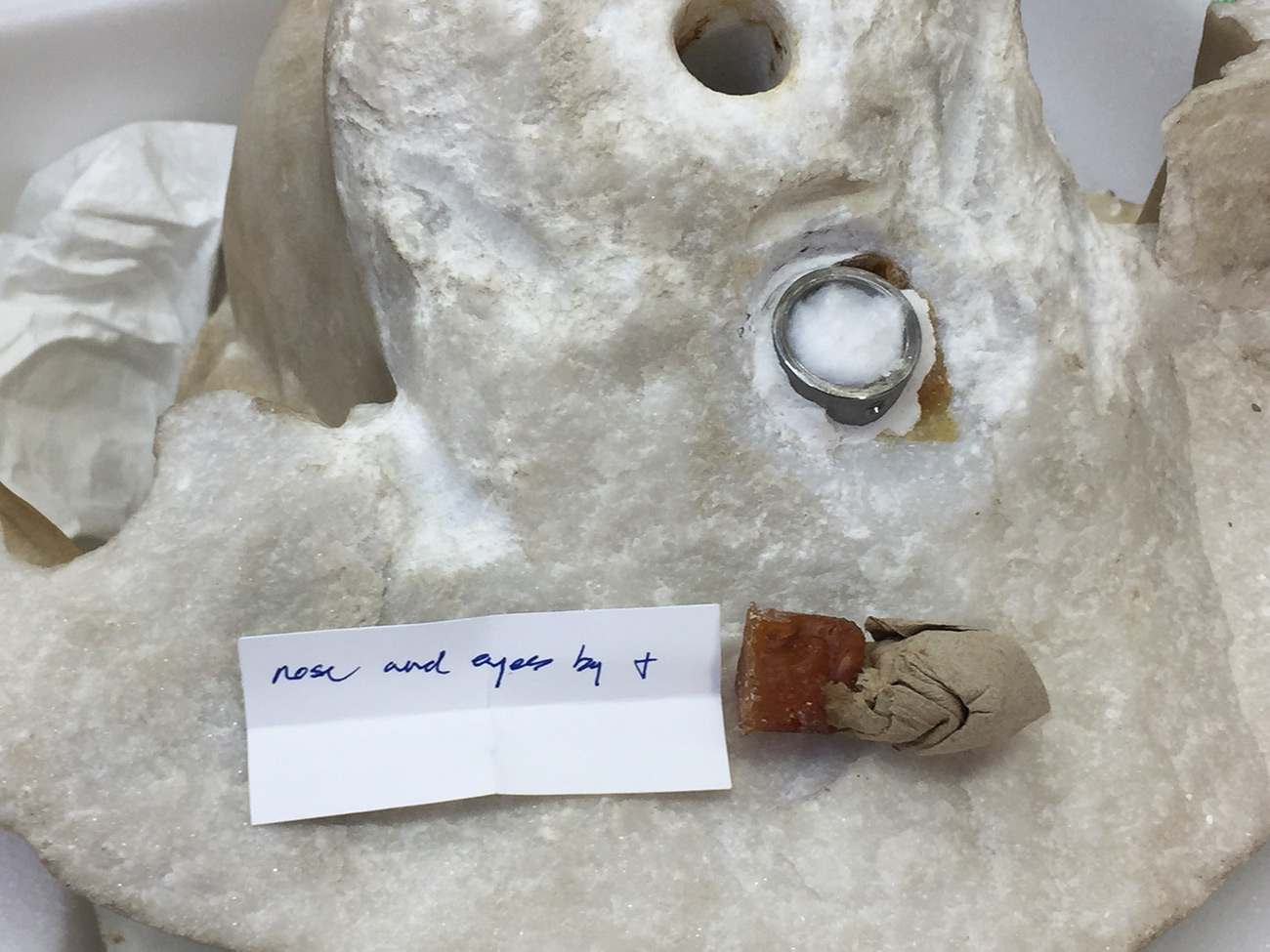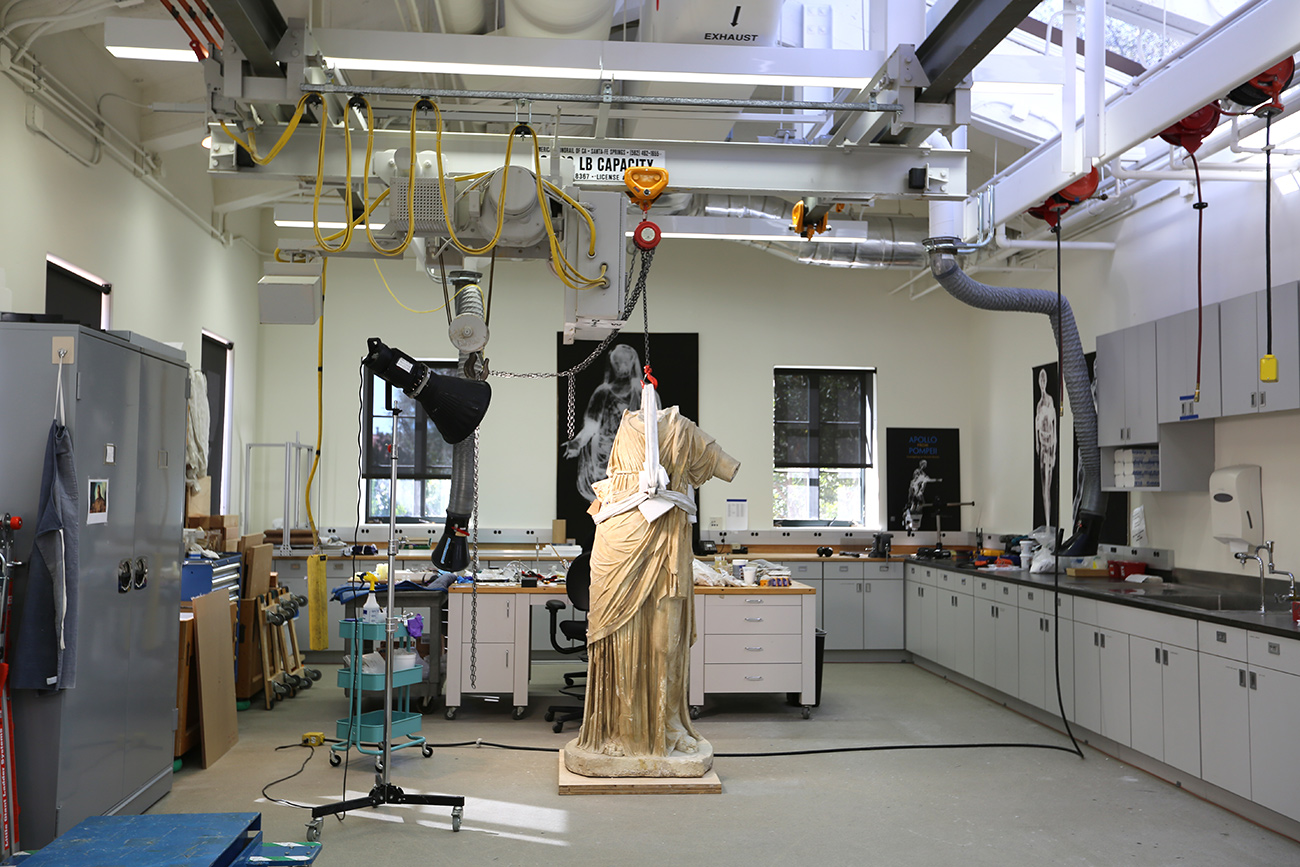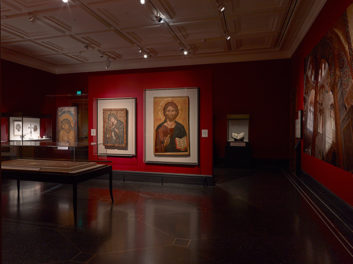A few months ago we reported on the rediscovery of a marble head that completes a six-foot-tall ancient Roman sculpture in the Getty Museum’s collection. The head has now arrived in the stone conservation studio at the Getty Villa, and conservator Eduardo Sanchez is making plans to rejoin the two.
Reattaching a missing piece of a sculpture sounds simple enough, but as I quickly learned from Eduardo, it’s painstaking, detailed work that—like all art conservation projects—sometimes comes with surprises.
Hidden Handwriting
The first surprise came as Eduardo examined the 82-pound head, which is resting comfortably upside down inside the Villa’s stone conservation studio. He found two holes drilled into the neck in modern times. One was typical and contained a section of a stainless steel tube used to attach the head to a standard pin-and-pedestal display. The second hole, however, was perplexing: hiding under a layer of paint and polyester fill, it was haphazardly plugged with resin and a wadded-up paper towel. When Eduardo pulled out the plug to investigate, he spotted a tiny piece of paper within, announcing “nose and eyes by t.”

The two holes on the underside of the head. The hole at left (further forward on the neck) came filled with paper towels and resin. The hole at right was fitted with a metal mount for a display pin.

Close-up of the resin-and-paper plug and the mysterious note found below.
Who is “t”? Eduardo has no idea, but we’re hoping someone reading this might know. (If you do, please leave a comment!) We have three clues: the note is in confident English; the head was in primarily European collections until 2008, when it was purchased by an American gallery; and paper on which the note is written hasn’t yellowed, so it must be pretty recent. Eduardo’s best guess is that the note was added in the last five to ten years by a restorer.
As to why this second hole was plugged up, Eduardo suspects it was to conceal a simple goof. The first hole wasn’t drilled in the right spot to display the head without view of the mounting rod, so “t” or his associate filled it in with some handy scraps and tried again.
(In case you’re wondering—I definitely was—this isn’t the first time Eduardo has found a piece of paper slipped into an ancient artwork by some anonymous hand from the past. He and colleagues once found a wadded-up page from a nineteenth-century medical journal in a drill hole of a marble sculpture, and a 1903 advertisement glued to the back of a mosaic.)
As for “nose and eyes,” Eduardo suspects that the statue’s right eye and eyebrow, as well as her nose, were damaged over time and were replaced in plaster by “t.” Restorers of the 1700s and 1800s often carved broken and irregular surfaces to smooth and prepare them for the addition of newly carved restorations. So missing sections like broken noses—plus ears, arms, and drapery fragments—would receive modern replacements. Did this happen to our head? If so, did “t” remove the nose job and redo it? Eduardo doesn’t yet know, but he is scheduling X-rays of the head to show a clear picture under the restored surfaces.

Studio view of the head, pre-conservation. Head of a Veiled Woman, about A.D. 175, Roman. Marble, 13 in. high. The J. Paul Getty Museum, 2016.38
Cleaning the Debris of the Past
Working on the head isn’t his only task; Eduardo also has an impressive to-do list for the body. At the top of the list is removing grime—plasters, resins, caulks, and paints—added by restorers over the past few centuries. These yellowed, flaking deposits are heaviest on the upper torso, where early restorers tried to disguise the joint separating the two blocks of marble used to carve the statue. Freeing the seam will give a better idea of the statue’s original appearance and enable conservators to study how the ancient sculptor fastened them together. Eduardo has already started removing the debris by hand, slowly revealing the original marble join.

The 2,000-pound body is secured to a heavy-duty hoist in the Getty Villa’s stone conservation studio as an added safety measure in the event of an earthquake during the conservation work.

Discolored plaster and cement mar the appearance of the statue, especially in a band around the torso where previous restorers disguised the original marble joint line.

Eduardo uses a mallet and a metal tool to carefully remove the restoration material from the space between the two marble blocks.
Like most ancient Roman sculptures, our mystery woman spent much of her life outdoors, and it shows. Rainwater dribbling down the drapery folds caused discoloration to the beautiful Parian marble, both by bringing minerals within the stone to the surface and by depositing added materials and pollutants. To remove these incrustations as well as past restorers’ additions, Eduardo will use water-based chemical solutions or a targeted laser.

The dark grey band running diagonally down the drapery folds of the statue is calcareous (chalky) material that has adhered like cement to the surface over time.
As Eduardo deals with the physical remains of the past, curators have been busy scrutinizing archival sources to shed more light on our mystery woman’s past. Curatorial assistant Judith Barr has traced the sculpture’s whereabouts back to 1881, when it was part of the collection at the Palazzo Sciarra in Rome. An early twentieth-century black-and-white photograph depicts the statue with added arms typical of seventeenth-century restorations, but we don’t know when and where they were added and removed.
As he works, Eduardo is bagging materials he removes so they can be tested by scientists at the Getty Conservation Institute and specialized external labs. Understanding the composition of this material will offer a fuller picture of the statue’s history.

Eduardo is preserving, labeling, and dating the material he removes during the cleaning of the statue.
A Twentieth-Century Beheading
The head also yielded another surprise: evidence of its own beheading. The deed was accomplished by electric drill, inserted in seven places around the neck. The weakened head was then whacked off, likely using a hammer and a blunt object as a lever.
Why? Perhaps an art dealer thought the head would be more saleable alone, since it’s easier to display in a living room than a two-thousand-pound statue. Judith’s research suggests that the statue still had her head as late as 1937, so the team surmises that the beheading took place between then and 1971, when the Getty Museum was offered the body for sale.

The head was removed from the body by electric drill. The angled mark just above and to the right of Eduardo’s right hand is one of seven spots where a wide drill bit was inserted. Matching drill marks can be found on the top of the torso.
Many of you who read our first post on this statue wondered how we can one know for sure that the head and the body really come from the same draped lady. Holding the 82-pound head directly on to the body to check the fit would have offered proof, but it’s difficult and risky. Instead, Eduardo teamed up with fellow conservator Jeff Maish to create a mold of the bottom of the head in biomedical foam, the same material used to fit custom orthotics. When they placed the plaster neck cast onto the torso, it fit perfectly. Drill marks on the underside of the head and the top of the torso also match, further confirming that the head and body were once joined.

Eduardo holds the cast of the underside of the head-break joint, used to ensure fit. It’s a perfect match for the top of the torso, minus a small spot in the front that was accidentally chipped away during the removal of the head.
When cleaning and study is done, and the time comes to reattach the two, Eduardo will mount the head on a custom stainless steel locking pin made to slide into the torso, then buttress the crack between head and body with removable fill material. Next, curators will determine the ideal angle of the figure for display and mountmakers will create an interface (a resin membrane between the statue’s base and a level surface) to securely position the bottom of the marble statue to a steel frame. The sculpture will be anchored to its support base with a sizeable metal pin.
As all this work moves forward, the team will decide when exactly the statue is ready go back on display in the galleries. Visit us here on The Iris for glimpses into the project as it continues, including any new surprises that crop up!





It’s a wonderful effort by Eduardo, All very Best for his Success, from New Delhi, India, a Faculty, Associate Professor, in College of Art, New Delhi, Delhi University, India….I’m a Practicing Painter and I teach Drawing, Painting and Art History to the students of BFA, Grad Level….
Royal Athena Galleries has this head catalogued as “Head of Faustina II, wife of emperor Marcus Aurelius”. Does the Getty agree with this assessment?
I viewed the draping of the sculpture-quite magnificent??? The head was beautifully designed. The museum will never know the person who was the model for the sculpture-the Roman class of the female model??? atk
Hi Annette,
Thanks for your question. The statue is a common “type” of a draped matronly elite woman. Archival records show that before the head and body were separated, the statue was identified with Roman empress Faustina the Younger (not to be confused with her mother, Faustina the Elder). Both Faustinas are typically depicted with distinctive hairstyles; Faustina the Younger has a plaited wavy style with a center part, as does our head. Notes in our collection database state that she is “an older patrician woman wearing her hair in the style of the empress Faustina the Younger.”
For you and Steven, I will check with our curators about whether they believe this is indeed a depiction of Faustina II, or rather one “in the style of.”
I just wanted to briefly comment on one issue. The original appearance of the statue can never be achieved, therefore it begs the question of whether removing the work of previous restorers is necessary or even justifiable. The article does explain why they are doing it, with the prospect of better understanding how ancient sculptors fastened the two pieces of marble. The problem that I have with this decision is that a life of an object is not limited to only its “original” context as it came to survive/live for almost 2,000 years. The decision to prioritize its original appearance is our own. I find this point often overlooked. On the other hand I see great value in learning more about the sculptural processes that made this beautiful sculpture.
Hi Ogi, Thanks for your comment! You are right that the past restorations of the piece are an important part of its history and that the “original” appearance cannot ever be achieved. It’s a complex topic that could be the subject of its own post, and I didn’t do it justice here.
A few resources on this topic that may be of interest: title in our Virtual Library on restorations of marble, symposium papers on changing practices in the restoration of ancient bronzes, exhibition material on restoration of ancient Greek vases and an Roman marble.
I’ll quote from that last link because it goes directly to your question:
Perhaps. Does the restorer say a little prayer while doing such work?
Must have been a violent time to break a head from an ancient piece as this.
John